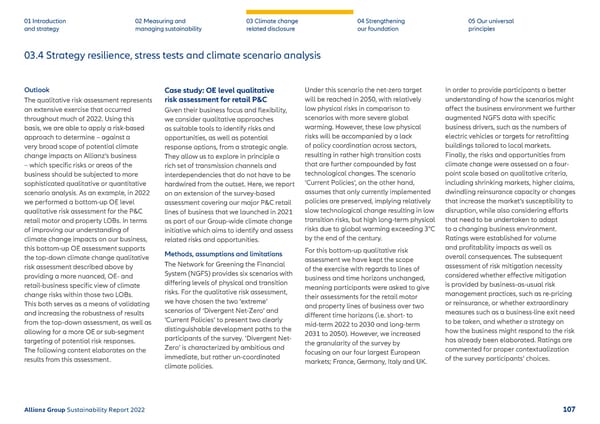03.4 Strategy resilience, stress tests and climate scenario analysis 01 Introduction and strategy 02 Measuring and managing sustainability 03 Climate change related disclosure 04 Strengthening our foundation 05 Our universal principles Outlook The qualitative risk assessment represents an extensive exercise that occurred throughout much of 2022. Using this basis, we are able to apply a risk-based approach to determine – against a very broad scope of potential climate change impacts on Allianz’s business – which specific risks or areas of the business should be subjected to more sophisticated qualitative or quantitative scenario analysis. As an example, in 2022 we performed a bottom-up OE level qualitative risk assessment for the P&C retail motor and property LOBs. In terms of improving our understanding of climate change impacts on our business, this bottom-up OE assessment supports the top-down climate change qualitative risk assessment described above by providing a more nuanced, OE- and retail-business specific view of climate change risks within those two LOBs. This both serves as a means of validating and increasing the robustness of results from the top-down assessment, as well as allowing for a more OE or sub-segment targeting of potential risk responses. The following content elaborates on the results from this assessment. Case study: OE level qualitative risk assessment for retail P&C Given their business focus and flexibility, we consider qualitative approaches as suitable tools to identify risks and opportunities, as well as potential response options, from a strategic angle. They allow us to explore in principle a rich set of transmission channels and interdependencies that do not have to be hardwired from the outset. Here, we report on an extension of the survey-based assessment covering our major P&C retail lines of business that we launched in 2021 as part of our Group-wide climate change initiative which aims to identify and assess related risks and opportunities. Methods, assumptions and limitations The Network for Greening the Financial System (NGFS) provides six scenarios with differing levels of physical and transition risks. For the qualitative risk assessment, we have chosen the two ‘extreme’ scenarios of ‘Divergent Net-Zero’ and ‘Current Policies’ to present two clearly distinguishable development paths to the participants of the survey. ‘Divergent Net- Zero’ is characterized by ambitious and immediate, but rather un-coordinated climate policies. Under this scenario the net-zero target will be reached in 2050, with relatively low physical risks in comparison to scenarios with more severe global warming. However, these low physical risks will be accompanied by a lack of policy coordination across sectors, resulting in rather high transition costs that are further compounded by fast technological changes. The scenario ‘Current Policies’, on the other hand, assumes that only currently implemented policies are preserved, implying relatively slow technological change resulting in low transition risks, but high long-term physical risks due to global warming exceeding 3°C by the end of the century. For this bottom-up qualitative risk assessment we have kept the scope of the exercise with regards to lines of business and time horizons unchanged, meaning participants were asked to give their assessments for the retail motor and property lines of business over two different time horizons (i.e. short- to mid-term 2022 to 2030 and long-term 2031 to 2050). However, we increased the granularity of the survey by focusing on our four largest European markets; France, Germany, Italy and UK. In order to provide participants a better understanding of how the scenarios might affect the business environment we further augmented NGFS data with specific business drivers, such as the numbers of electric vehicles or targets for retrofitting buildings tailored to local markets. Finally, the risks and opportunities from climate change were assessed on a four- point scale based on qualitative criteria, including shrinking markets, higher claims, dwindling reinsurance capacity or changes that increase the market’s susceptibility to disruption, while also considering efforts that need to be undertaken to adapt to a changing business environment. Ratings were established for volume and profitability impacts as well as overall consequences. The subsequent assessment of risk mitigation necessity considered whether effective mitigation is provided by business-as-usual risk management practices, such as re-pricing or reinsurance, or whether extraordinary measures such as a business-line exit need to be taken, and whether a strategy on how the business might respond to the risk has already been elaborated. Ratings are commented for proper contextualization of the survey participants’ choices. Allianz Group Sustainability Report 2022 107
 Sustainability Report 2022 | Allianz Page 107 Page 109
Sustainability Report 2022 | Allianz Page 107 Page 109